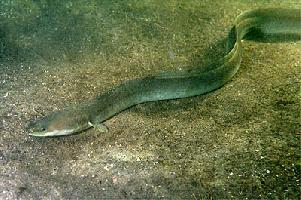
Popis zvířete
The Japanese eel (Anguilla japonica) is a fascinating and unique species of fish that is native to the waters of East Asia, including Japan, Korea, China, and parts of the Philippines and Vietnam. This species is of great ecological, cultural, and economic significance in these regions, especially in Japan where it is a popular delicacy.Physical Description:
The Japanese eel possesses a long, slender body typical of eels, which allows it to navigate through both open waters and tight spaces within riverbeds and estuaries. They exhibit a smooth, scaleless skin that is covered in a layer of mucus, helping to protect them from parasites and infections. The coloration of the Japanese eel varies with age and environment; juveniles, known as elvers or glass eels, are transparent, while adults range from a dark brown to a greenish or yellowish-brown on their dorsal (upper) side, transitioning to a paler, sometimes almost white, belly.
Lifecycle and Reproduction:
One of the most intriguing aspects of the Japanese eel is its complex lifecycle, which includes a remarkable migration pattern. They are catadromous, meaning they live in freshwater but migrate to the sea to spawn. The spawning occurs in the western North Pacific, near the Mariana Islands, in a process that remains largely a mystery to scientists. After spawning, the adults die, and the newly hatched larvae, known as leptocephali, drift with the ocean currents back towards East Asia. This journey can take several months, during which they undergo a transformation into glass eels before entering freshwater or brackish environments. Here, they grow into adulthood, a process that can take several years.
Diet and Predation:
Japanese eels are nocturnal predators, feeding primarily at night. Their diet consists of a variety of aquatic animals, including worms, crustaceans, insects, and small fish. They rely on their acute sense of smell to locate prey. Despite being predators, Japanese eels also face threats from other species, including humans, birds, and larger fish, making them an integral part of their ecosystem's food web.
Conservation Status:
The Japanese eel is currently listed as endangered by the International Union for Conservation of Nature (IUCN). Overfishing, habitat loss due to river modification and coastal development, pollution, and barriers to migration such as dams, have all contributed to a significant decline in their populations. Conservation efforts are underway to protect this species, including habitat restoration, the establishment of aquaculture systems to reduce pressure on wild populations, and international cooperation to manage and sustainably harvest eel populations.
Cultural and Economic Importance:
In Japan and other parts of East Asia, the Japanese eel is more than just a fish; it is a cultural icon and a culinary delicacy. Unagi (the Japanese word for eel) dishes are popular, especially during the summer, where it is believed to provide strength and vitality. The farming of Japanese eels is a significant industry, but the decline in wild populations has led to increased prices and a push towards more sustainable practices.
In conclusion, the Japanese eel is a species of great interest and importance. Its unique lifecycle, ecological role, and significance to human culture make it a subject of fascination and concern. Conservation efforts are critical to ensuring that future generations can continue to appreciate and benefit from this remarkable species.
Podobná zvířata
Nové fotografie zvířat
Top 10 zvířat
- Chinese water dragon (Physignathus cocincinus)
- Galápagos tortoise (Geochelone nigra complex)
- Dolphin gull (Leucophaeus scoresbii)
- Japanese macaque (Macaca fuscata)
- Colombian red howler (Alouatta seniculus)
- Sea urchins (Echinoidea)
- Diana monkey (Cercopithecus diana)
- Moustached guenon (Cercopithecus cephus)
- Colossal squid (Mesonychoteuthis hamiltoni)
- Common reed warbler (Acrocephalus scirpaceus)

